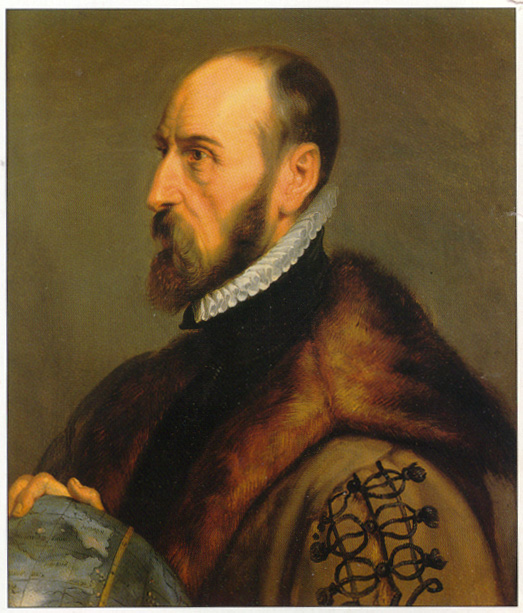

In 1886, inventor Joseph Barker Stearns built a mansion named " Norumbega Castle", which still stands on US Route 1 in Camden, Maine, overlooking Penobscot Bay. The town of Bangor, Maine, commemorated the legend during the nineteenth century, naming their municipal hall "Norumbega Hall". It often appeared on subsequent European maps of North America, lying south of Acadia in what is now New England. In 1542, Jean Allefonsce reported that he had coasted south from Newfoundland and had discovered a great river. It may mean "quiet place between the rapids" or "quiet stretch of water". The word "Norumbega" was originally spelled Oranbega in Giovanni da Verrazzano's 1529 map of America, and the word is believed to derive from one of the Algonquian languages spoken in New England. It was alleged that the houses had pillars of gold and the inhabitants carried quarts of pearls on their heads. Norumbega, or Nurembega, is a legendary settlement in northeastern North America which was featured on many early maps from the 16th century until European colonization of the region. Due chiefly to its helicopters, Ortelius has delivered passengers to some of the least-visited and most sought-after destinations in the polar regions, such as the emperor penguin colony on Snow Hill Island – a feat we achieved in 2017, 2018, and 2019.Part of Abraham Ortelius' atlas from 1570, showing "Norvmbega" among other somewhat mythical names for various areas as well as several phantom islands.
Facts about abraham ortelius windows#
The vessel offers various cabin types, including quadruple cabins, twin porthole cabins, and superior cabins, all with at least two portholes or windows as well as a private shower and toilet.ġ5. Ortelius is the only ship in our fleet capable of stationing helicopters, which can enable passengers to visit otherwise inaccessible areas (see below).ġ4. There are 10 Zodiac boats on board Ortelius for making safe and swift shore landings.ġ3. A bar and spacious lecture room are built into the vessel, along with ample deck space from which to view the seas, landscapes, and exotic polar wildlife.ġ2. Ortelius has an average cruising speed of 10.5 knots.ġ1. The ship’s propulsion is powered by a Cagielski Sulzer 6 ZL 40 / 48 engine.ġ0. Ortelius has a length of 90.95 meters (298.39 feet), a breadth: of 17.20 meters (56.43 feet), a draft of 5.4 meters (17.72), and a displacement of 4,090 tonnes (4,508 US tons).ĩ. Manned by 22 nautical crew members and 19 hotel staff, Ortelius also carries eight expedition specialists and one doctor during her voyages.Ĩ. Ortelius holds 108 passengers in 52 cabins as of the Arctic season 2020.ħ. The vessel has one of the highest ice-class notations (UL1, equivalent to 1A) and is suitable to navigate in loose pack ice.Ħ. Ortelius is classed by Lloyd’s Register in London and flies the Dutch flag.ĥ. Its publication is often seen as the start of the Dutch Golden Age of Cartography.Ĥ. She was renamed after Abraham Ortelius (1527 -1598), who in 1570 published the first modern world atlas: Theatrum Orbis Terrarum, or Theater of the World. Originally, Ortelius was named Marina Svetaeva.ģ. Built in Gdynia, Poland in 1989, Ortelius served as a special-purpose vessel for the Russian Academy of Science until Oceanwide Expeditions purchased it.Ģ. Here are 15 additional features, figures, and facts about this lovely little vessel.ġ. The kind that can fly you to really cool, otherwise inaccessible areas – which we’ll discuss later.īut there’s even more to Ortelius than all of that. Not only is Ortelius one of our longest-running ships, her specs rival many of the new vessels being built today: great decks for viewing landscapes and wildlife, comfortable cabins for rest and relaxation, and cozy common areas for trading tales with your fellow passengers. Which is why we’re going to do a little gushing about our m/v Ortelius. And we think the same can be said of polar travel companies and their expedition cruise ships. It’s natural for parents to be proud of their children, if not biased.


 0 kommentar(er)
0 kommentar(er)
